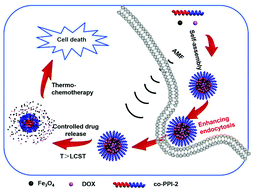Fabrication of thermoresponsive magnetic micelles from amphiphilic poly(phenyl isocyanide) and Fe3O4 nanoparticles for controlled drug release and synergistic thermochemotherapy†
Abstract
Amphiphilic thermoresponsive block helical poly(phenyl isocyanide) was synthesized by the polymerization of phenyl isocyanide using a Pd(II) complex catalyst as an initiator. The polymer could self-assemble into spherical micelles. The lower critical solution temperature (LCST) of the micelle solution was adjusted by changing the molar ratio of the hydrophobic segment to the hydrophilic segment and finally optimized to be 41 °C at a molar ratio of 1 : 2. After loading Fe3O4 nanoparticles, the magnetic complex micelles were prepared. The magnetic complex micelles demonstrated reversible thermoresponsiveness and obvious magnetic hyperthermia. Cell viability measurements indicated that the nanomaterials were well-biocompatible and nontoxic. The magnetic complex micelles could be used as nanocarriers to achieve controlled release of doxorubicin (DOX) by altering the temperature. Intracellular experiments demonstrated that the magnetic complex micelles showed excellent anticancer synergistic thermo-chemotherapy performance under an alternating magnetic field (AMF) owing to magnetic hyperthermia from micelle-loaded Fe3O4 nanoparticles and effective drug release due to the morphology change of thermoresponsive poly(phenyl isocyanide)s.



 Please wait while we load your content...
Please wait while we load your content...